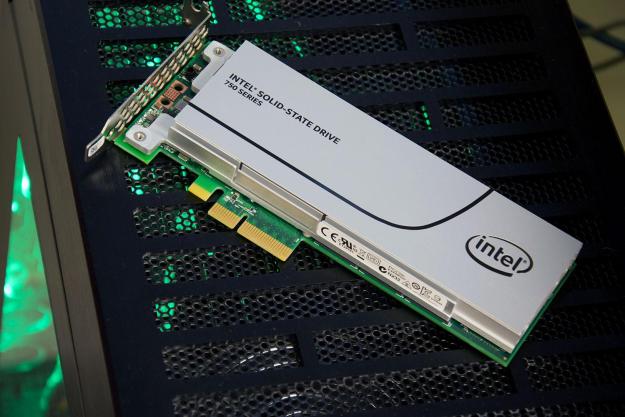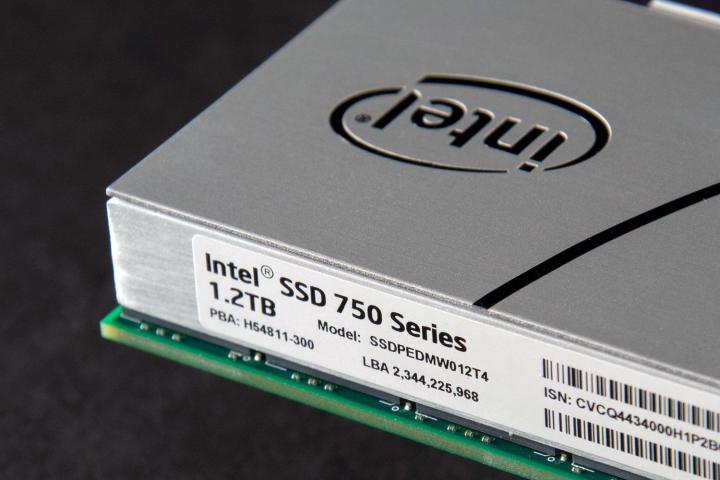
“Intel’s 750 Series is a performance triumph that costs a mint.”
- Easy to install
- PCI card looks slick
- Incredible performance
- Proves NVMe has potential
- PCIe card is large
- 2.5-inch drive requires uncommon connection
Solid-state drives have improved at breakneck speed since they first gained traction in the consumer space about five years ago. Advancements in controller technology and memory production have made the drives faster, more durable and more affordable by a huge margin. Today’s best SATA drives are several times quicker than their predecessors and enjoy better, more stable drivers.
The pace of progress has been so rapid that the SATA interface traditionally used to connect hard drives has become a bottleneck for many SSDs, despite the introduction of SATA 3.0, also known as SATA 6Gbps, in 2009. Fortunately the major players in the hard drive industry were aware of this problem, and they sat down to create an entirely new standard that can handle the potential for future SSDs. That standard is called Non-Volatile Memory Express (NVMe).
Intel introduced the first NVMe drives last year, but they targeted the enterprise market and, more specifically, data centers. Now, though, the chipmaker has released a consumer version: the 750 Series. Available in capacities between 400GB and 1.2TB, and as either a PCIe add-in card or 2.5″ drive, Intel hopes the 750 will open up a new world of hard drive performance, just as the company’s X18-M and X25-M did for SATA solid state drives more than a half-decade ago.
NVMe – PCIe’s more formal cousin
Hard-drive manufacturers have dealt with the limitations of SATA for several years already, as the best drives are quite able to saturate a single connection. To get around this, the quickest drives have turned to PCI Express, which offers plenty of internal bandwidth. NVMe also uses PCI Express, which leads to an obvious question. What’s the difference?
In a word, standardization. PCI Express wasn’t designed with storage drives in mind, so companies building such drives have had to use their own proprietary drivers, which weren’t plug-and-play, as a SATA hard drive normally is. Most PCI drives also lacked boot support, so they could only be used as secondary storage.
NVMe provides a standard for PCI Express drives. Microsoft has a driver that supports it in Windows, making NVMe plug-and-play like a SATA drive. There’s also a generic Linux driver available. Standardization gives motherboard manufacturers a single specification to adhere to, so they can bundle support into the BIOS and provide boot capability.
In short, the new standard finally makes PCI drives work like any other. In theory, at least.
Put the pedal down
A boatload of performance improvements come along with standardizing use of the PCI Express bus. Bandwidth is improved, of course. The Intel 750 Series uses four PCI Express 3.0 lanes, which together can handle the transfer of 4GB every second, at least in theory. A SATA 3.0 connection can only handle about 600MB per second.
Intel quotes latency on sequential reads and writes at 20 microseconds, a microsecond is one millionth of a second!
That’s not all. SATA drives connect through a device stack called Advanced Host Controller Interface, and it suffers from limitations in parallelism that can be detrimental to drive performance. Drives attempting to access a wide variety of data can run into command queuing issues, and there’s overhead that puts unnecessary load on a system’s processor when data transfers occur.
Finally, NVMe reduces latency relative to AHCI, which means data can be accessed even more quickly than before. And we do mean quick. Intel quotes latency on sequential reads and writes at 20 microseconds, and latency on random reads and writes at 120 and 45 microseconds, respectively. A microsecond is one millionth of a second!
A closer look at the 750
The Intel 750 Series comes in two form factors. One is a standard PCI Express 3.0 x4 card that’ll fit in any existing motherboard with a free PCI Express slot. A hair less than seven inches long and boasting a beefy silver heatsink, this model looks like it means business. It’s small enough to fit even in small form factor desktops, but cooling could be an issue in such systems if the motherboard’s arrangement doesn’t provide much space between PCIe slots and the drive ends up bumping up against a video card.
The 2.5-inch drive is more unusual. While designed to look like a 2.5-inch SATA solid state drive, it too uses NVMe and thus PCI Express. From one side it looks like any ordinary SSD from the past five years, but on the other there’s a heatsink, a dead giveaway that something strange is going on.
How do you connect it? With a SFF-8643 cable. While this connection is common on server setups and enterprise motherboards, it’s still a rare sight on consumer motherboards. Intel is trying to change that by re-branding the connection to the slicker-sounding U.2. The wide plug connects to a single strip of contacts on the card, with a breakout power cable so it fits right in alongside the other 2.5-inch drives. If you don’t have a U.2 port, you can also connect the drive to an M.2 slot using an adapter.
Installation and setup
Popping the 750 Series PCI card into our tower desktop required slightly more effort than expected, as the card comes with two different clips, one for a full-sized PCIe slot, and one for a half-height. The latter was installed by default, which seems odd, since most desktops are full-size towers. Changing it was only a matter of replacing two screws, though, and took no more than a minute. That performed, we slipped the drive into place and turned on our test system.
The 2.5-inch version was no more complicated than any other SSD. Our Asus X99-Deluxe motherboard had a U.2 connector on it, which sat right next to the SATA ports for easy cable management, and a small breakout from the U.2 cable took standard SATA power. The 2.5-inch drive is, however, at the thicker end of the 2.5-inch form factor. Some cases designed with SSD drive bays may not be able to accommodate it, forcing owners to fall back on a 3.5-inch to 2.5-inch drive bay adapter.
Sustained read/write performance was several times better than the best SATA SSDs.
Only two platforms are designed to work with the 750: Intel’s Z97 and X99. If you have either, and run a current version of Windows 8 or newer, a driver should be automatically detected and installed. Windows 10 worked, as well. Intel also provides its own driver, which we used for testing the drive, because the company says it’s necessary to obtain its full performance potential.
Booting from the drive is no fuss. We found installing Windows to be no different from a common SATA SSD, so it’s possible to use the 750 in a brand new desktop as the boot drive. As mentioned earlier, most previous PCIe drives struggled with or simply did not support the same capability.
There’s not much else to say. NVMe seems to have achieved its goal of making PCIe drives just as painless as their SATA peers. We had no issues with installation or testing. No bugs, no glitches, no failed boots.
The PCI card is quicker than it’s 2.5-inch sibling
We first put the drive to work in Crystal DiskMark, a test that we regularly use to judge all notebooks and desktops, and it showed the 750 Series PCIe card off to strong start.
In the 100MB sequential transfer test we recorded read speeds of 1,346 megabytes per second and write speeds of 1,291MB/s. These figures are easily the highest we’ve ever recorded from a single drive.
The previous best results we saw came from the Origin EON17-X, which hit read speeds of 1,179MB/s and write speeds of 891MB/s thanks to its Samsung M.2 solid-state drive. We’ve also recorded speeds approaching, but not exceeding, 1GB per second from systems that have dual SATA SSDs in a RAID0 configuration. Most single SATA SSDs, though, are lucky to break 500MB/s.
Next up was IOmeter, which we used to perform sequential and random access tests. In a sequential 128 kilobyte read/write loop, the drive hit 2,664MB/s in reads and 1,226MB/s in writes. Random testing with a 4KB payload produced read speeds of 1,649MB/s and write speeds of 1148MB/s.
While we don’t usually use IOmeter in drive tests, and so lack many results for comparison, it’s clear these numbers are extremely high, and are two to three times better than the results produced by the best SATA drives.
The 2.5-inch U.2 version of the card didn’t perform quite as well, despite similar internal hardware. In the CrystalDiskMark test, it only averaged 1,158MB/s read and 973.8MB/s write. That’s an okay read speed, albeit short of the add-in card, but its write speed is below what we’re used to seeing from PCIe drives.
HDTune told a similar story. The 2.5-inch drive came in at just 697MB/s in the more demanding test, around half of competing drives, like the Samsung SM951, a common NVMe drive. Its .036 second access time is also fine, but no faster than the other drives.
Warranty
Intel claims that the 750 Series provides industry-leading durability, and it backs up that claim with a five-year warranty. That’s certainly one of the better warranties in the business, though it’s not unheard of. In any case, experiments with solid-state drive reliability have already shown that Intel has good reason for providing such a long warranty. SSDs can take an incredible amount of read/write cycles before failing.
Conclusion
The Intel 750 Series is easily the quickest solid state drive we’ve ever reviewed. Its performance is an incredible leap forward and, more importantly, its use of the new NVMe standard means the drive is fully bootable and operates as a plug-and-play solution with no additional drivers required (though installing them improves performance).
Cutting-edge technology isn’t cheap, however. The 1.2TB drive we reviewed retails for $1,029, and the smaller 400GB drive is $389. SATA solid state drive prices have dropped substantially in recent years; it’s now possible to pick up a Samsung 95o Pro solid state drive with 512GB of capacity for about $300.
Surprisingly, Intel’s drive doesn’t seem a poor value if compared to SATA drives on the basis of read/write performance. The Intel drive is several times more expensive, yet also several times quicker. The 2.5-inch version costs the same price at each storage level, but its reduced read and write speeds may push people towards the add-in card, if they have the room.
The difference is hard to notice in everyday use, though, and that’s the rub. This isn’t the kind of performance most people will use every day. It’s most relevant to people who work with very large files regularly, like 4K video content, and it’s complete overkill for most everyone else.
Still, this is an impressive technical achievement that pushes solid state drives to new heights. It also serves as an effective proof-of-concept for the NVMe standard. The 750 Series is a triumph of engineering, even if it’s not a drive everyone needs to buy.
Highs
- Easy to install
- PCI card looks slick
- Incredible performance
- Proves NVMe has potential
Lows
- PCIe card is large
- 2.5-inch drive requires uncommon connection
Updated 6/7/2016: Brad Bourque updated this review to include results and photographs from the Intel 750 Series 2.5-inch SSD.
Editors' Recommendations
- The best SSDs for 2023
- Amazon shoppers warned of portable SSD drive scam
- The redemption of Arc begins — Intel A750 beats Nvidia by 17%
- World’s first 200TB SSD is nearly here, but you can’t use it
- The best NVMe SSD in 2022








